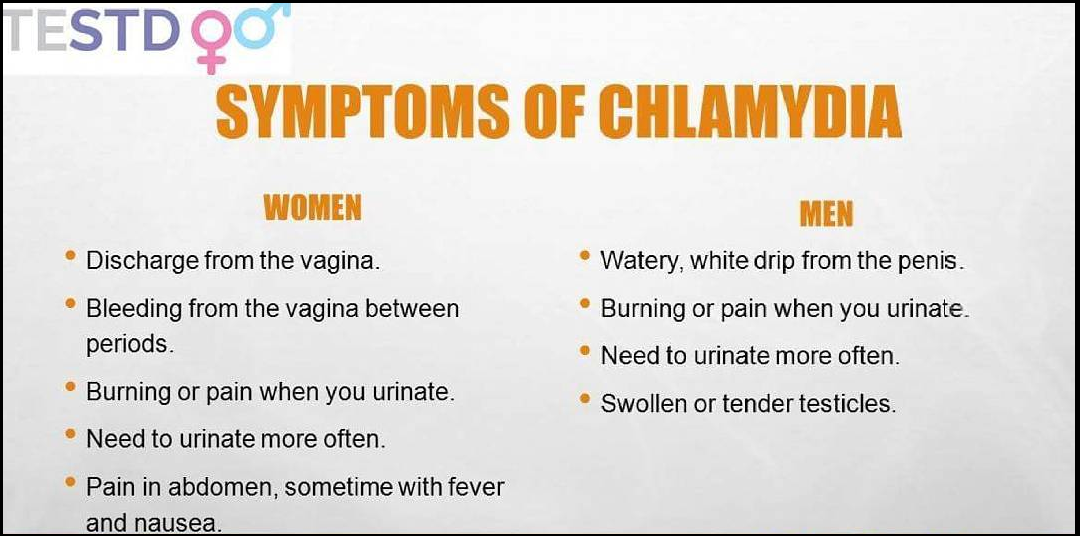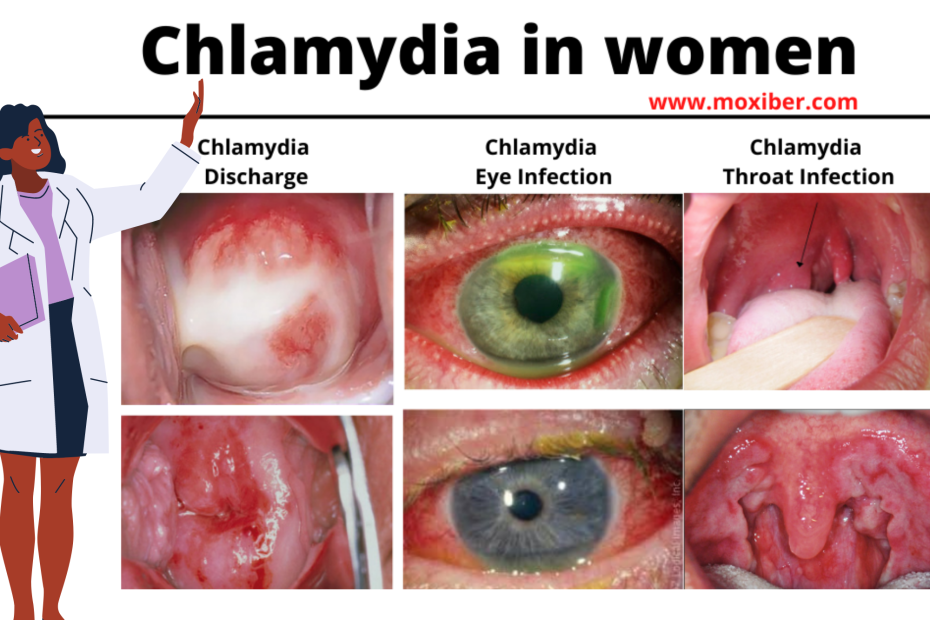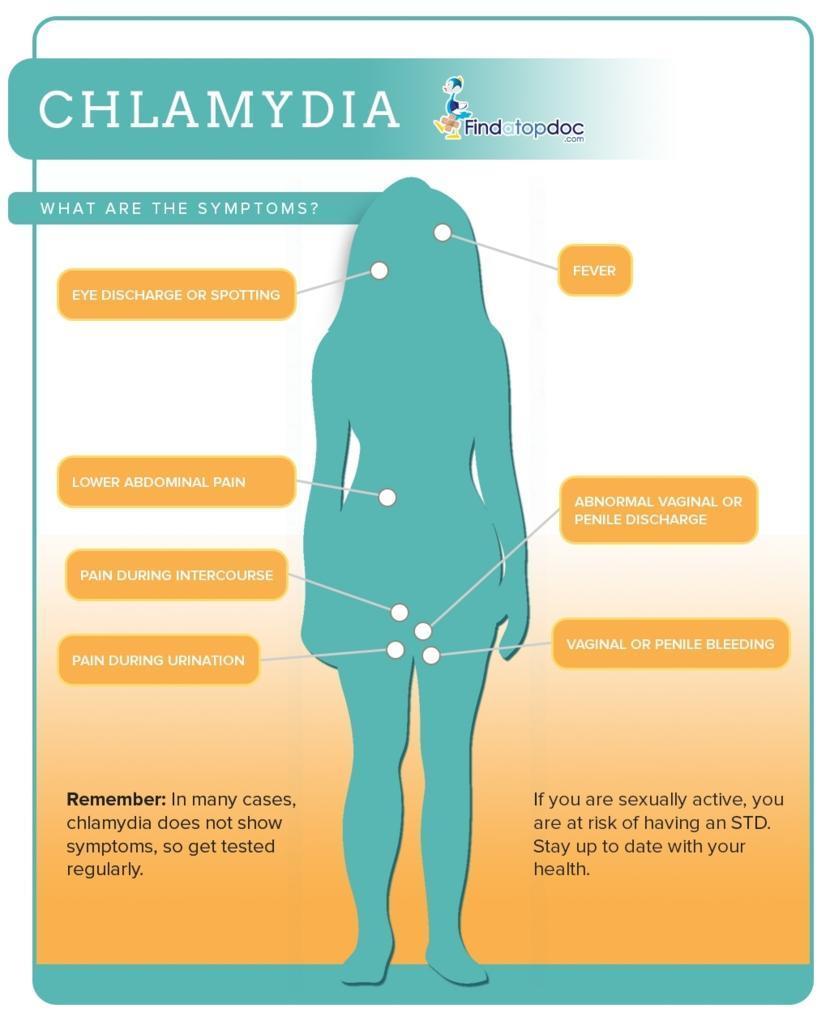Your Partners Reproductive Issues
Chlamydia shows its signs in about 50% of all male sufferers, which means women should monitor their partners closely. It may feel uneasy to question a long-term partner, but it will surely help you find out crucial information. Unfortunately, these talks are taboo most of the time. Women can also find out about their partners difficulties if they choose to state them. However, no woman should count on this occurrence. They should always ask about these things when suspicious. Ultimately, it is better to feel uncomfortable during a conversation than remain ignorant of a potentially grave threat.
Chlamydia Symptoms In Women
Chlamydia symptoms in women are very difficult to spot. It is important to pay close attention your body and to seek out treatment if you notice any of these symptoms:
- Yellowish, strong smelling or abnormal discharge
- Internal swelling
- Painful and more frequently urination
- Low-grade fever
- Pain in the lower stomach or back
- Bleeding between periods
Most of these symptoms could also be the result of nothing more than stress or dietary changes. However, it is extremely important to have them checked out as soon as you notice them to be sure you treat any potential serious illness immediately.
Chlamydia is largely asymptomatic in both men and women, making it very hard to catch before complications arise. If you notice any of the above symptoms in you or your partner, be sure to get tested as soon as possible. You can visit a sexual health clinic, your doctor, or free clinic to get this testing done. The long-term impact on your health from untreated chlamydia can be serious, making it crucial to visit a healthcare professional as soon as possible.
Dr.JackJohnson, MD
How Is Chlamydia Screening Done
A person can test for chlamydia at home or in the lab. They can take either a urine sample or a swab.
- Females can take a swab, place it in a container, and send it to a laboratory.
- Males will usually use a urine test.
A doctor can advise individuals on the best option. They may also recommend rectal or throat testing, especially for people who are living with HIV.
Home screening tests are available, but it is not always easy to do them correctly at home. A healthcare provider will usually recommend following up on any home tests by visiting a doctors office.
The person will likely need to provide a urine sample for a test to confirm a diagnosis. After treatment, they will need to retake the test to ensure that the treatment has worked.
If anyone wishes to try home testing, chlamydia screening test kits are available for purchase online.
Don’t Miss: Does Any Antibiotic Cure Chlamydia
Where Can I Get More Information
Health care providers with STD consultation requests can contact the STD Clinical Consultation Network . This service is provided by the National Network of STD Clinical Prevention Training Centers and operates five days a week. STDCCN is convenient, simple, and free to health care providers and clinicians. More information is available at www.stdccn.orgexternal icon.
Division of STD Prevention Centers for Disease Control and Prevention
Research Triangle Park, NC 27709-38271-800-783-987
References
1. OFarrell N, Morison L, Moodley P, et al. Genital ulcers and concomitant complaints in men attending a sexually transmitted infections clinic: implications for sexually transmitted infections management. Sexually transmitted diseases 2008 35:545-9.
2. White JA. Manifestations and management of lymphogranuloma venereum. Current opinion in infectious diseases 2009 22:57-66.
3. Kreisel KM, Spicknall IH, Gargano JW, Lewis FM, Lewis RM, Markowitz LE, Roberts H, Satcher Johnson A, Song R, St. Cyr SB, Weston EJ, Torrone EA, Weinstock HS. Sexually transmitted infections among US women and men: Prevalence and incidence estimates, 2018. Sex Transm Dis 2021 in press.
4. CDC. Sexually Transmitted Disease Surveillance, 2019. Atlanta, GA: Department of Health and Human Services April 2021.
5. Torrone E, Papp J, Weinstock H. Prevalence of Chlamydia trachomatis Genital Infection Among Persons Aged 1439 Years United States, 20072012. MMWR 2014 63:834-8.
Are Instant Tests Reliable

You can certainly find instant tests on the market, but these are not reliable. Being able to see results in minutes is worthless if they arent lab-certified. Many of the home STI testing kits you see on the market are just smoke and mirrors. These services may claim instant results but most of them use subpar testing methods. It is illegal to sell these within the United States.
On the other hand, at-home testing offers trustworthy and accurate results. These tests require that you provide a sample that will then be sent to a lab for, you guessed it, lab-certified results. The only difference from a clinic test is that you can screen for these infections from the comfort of your own home.
MyLAB Box offers discreet, FDA approved home testing STD kits for the most common sexual diseases and infections
Read Also: Having Chlamydia For A Long Time
Treatment And Medication Options For Chlamydia
A course of antibiotics is the treatment for chlamydia. Your doctor will decide which drug to prescribe, and at what dose, according to your individual medical needs and other aspects of your situation.
Its important to abstain from having sex until seven days after the start of your antibiotic treatment, to prevent the transmission of chlamydia to a sexual partner. If you have a partner who is being treated for chlamydia, the same recommendation applies to them.
If you have symptoms that persist for more than a few days after you start your treatment, see your doctor again to be reevaluated.
Because the symptoms of chlamydia are similar to those of gonorrhea, you should be treated for both infections if you test positive for chlamydia. Thats because its often faster and cheaper to just treat both infections than to order another test for gonorrhea after a positive test result for chlamydia.
After completing your antibiotic treatment for chlamydia, youll need to get tested again after three to four months or earlier, if recommended to check for reinfection.
While antibiotics can cure chlamydia, they cant reverse any permanent damage caused by the infection.
How Do You Get Chlamydia
Chlamydia is usually passed on through unprotected vaginal, anal or oral sex.
Chlamydia can be passed on through genital contact. This means you can get chlamydia from someone who has the infection if your genitals touch, even if you dont have sex or ejaculate .
You can also get chlamydia if you come into contact with infected semen or vaginal fluid, or get them in your eye.
Chlamydia cant be passed on through kissing, hugging, sharing towels or using the same toilet as someone with the infection.
Don’t Miss: Over The Counter Chlamydia Treatment Walgreens
Chlamydia Symptoms In Females
Chlamydia symptoms in females are rare. Roughly 7 in 10 women dont experience any symptoms. The infection may be asymptomatic, meaning that people dont know they have it.
If signs and symptoms occur, they usually happen one to three weeks after the exposure, but could start much later. The symptoms are often mild and passing, and easy to overlook.
Some of the potential signs and symptoms of chlamydia include:
- lower abdominal pain
Who Is Most Likely To Be Infected By Chlamydia
Studies have shown chlamydia infections to be the highest among women aged 15 to 24 years. Infection rates are highest in men at a slightly higher age range from 20 to 24 years old.
Population studies have tried to estimate what percent of the overall population is infected by Chlamydia. One extensive study of individuals between the age of 18 and 26 years found 4.2% to have Chlamydia infections.
Another national survey found 1.7% of people between 14 and 39 years had the infection. Out of all states, Alaska had the highest rates of Chlamydia.
Don’t Miss: Can Bv Cause Positive Chlamydia Test
Could You Catch Chlamydia From A Toilet Seat
The simple answer to this question is No. The Chlamydia is caused by Chlamydia Trachomatis bacteria and this cannot live outside the human body. So, it is not possible for the Chlamydia bacteria to be spread through the toilet seats.
However, you always have to be careful while using restrooms in public places and you have to clean them well before using them.
What Happens If Chlamydia Goes Untreated
A sexually transmitted infection of chlamydia can cause an infection of the cervix, urethra, and fallopian tubes in people with female reproductive organs .
As time progresses and an untreated chlamydia infection continues to spread, serious and long-term consequences like pelvic inflammatory disease , ectopic pregnancy, infertility, or chronic pelvic pain may develop in individuals with female reproductive organs. Chlamydia bacteria travel up the reproductive tract from the vagina through the cervix to the uterus, ovaries, and fallopian tubes, causing inflammation and infection. Once inside, the bacteria damage the ovaries and fallopian tubes, and can cause scarring . This can have long-term effects including infertility, as scar tissue can block the fallopian tubes, preventing sperm from fertilizing an egg. Ectopic pregnancies are also more common, as a fertilized egg may get stuck in the damaged fallopian tubeâthis can be life threatening.
Chronic pelvic pain is also a possible long-term consequence of untreated chlamydia infections and is a symptom of PID .
In people with male reproductive organs, chlamydia can cause an infection of the urethra and epididymis, the tube that collects and stores sperm from the testicles .
Don’t Miss: Long Term Effects Of Chlamydia
Who Is At Risk For Chlamydia
Any sexually active person can be infected with chlamydia. It is a very common STD, especially among young people.3 It is estimated that 1 in 20 sexually active young women aged 14-24 years has chlamydia.5
Sexually active young people are at high risk of acquiring chlamydia for a combination of behavioral, biological, and cultural reasons. Some young people dont use condoms consistently.15 Some adolescents may move from one monogamous relationship to the next more rapidly than the likely infectivity period of chlamydia, thus increasing risk of transmission.16 Teenage girls and young women may have cervical ectopy .17 Cervical ectopy may increase susceptibility to chlamydial infection. The higher prevalence of chlamydia among young people also may reflect multiple barriers to accessing STD prevention services, such as lack of transportation, cost, and perceived stigma.16-20
Men who have sex with men are also at risk for chlamydial infection since chlamydia can be transmitted by oral or anal sex. Among MSM screened for rectal chlamydial infection, positivity has ranged from 3.0% to 10.5%.6.7 Among MSM screened for pharyngeal chlamydial infection, positivity has ranged from 0.5% to 2.3%.7.8
Can You Get Chlamydia If You Use A Condom

A condom lowers your chances of getting chlamydia if used correctly.
Correct use of a condom includes:
Read Also: How Many Mg Of Azithromycin To Treat Chlamydia
Signs And Symptoms Of Chlamydia In Women
One of the most commonly transmitted sexual diseases is Chlamydia. This infection is due to a bacterium known as the Chlamydia trachomatis. The biggest problem with chlamydia is that this condition often goes unnoticed. In fact, it wont show any symptoms for many years since the patient first got infected. Almost 30% of women who have chlamydia will only notice the symptoms after about 3 weeks of the initial infection.
Here are 10 most common signs and symptoms of chlamydia in women.
How Do I Prevent Chlamydia
Using condoms every time you have sex can greatly reduce the risk of contracting chlamydia. Condoms should be used not just during ejaculation, but before any genital or sexual contact starts. If you are having oral-vaginal sex, use a dental dam to stay protected.
Ask a partner whether theyâve been tested recently for STIs before starting sexual contact. If a partner has sex with multiple people, ask about their STI status and encourage them to also get tested. Limiting the number of sexual partners you are exposed to will also decrease your risk of contracting chlamydia.
For people with female reproductive organs, a yearly gynecologic visit is recommended, even for those in a monogamous longterm relationship. People who are sexually active should always be screened for chlamydia. The screening can easily be performedâon a urine specimen, or as part of a pelvic exam.
You May Like: What Causes Chlamydia In Males
Who Should Get Tested For Chlamydia
Pregnant women should be screened for chlamydia according to the above guidelines, with a second test during the third trimester of pregnancy. If a pregnant woman tests positive for chlamydia, she should be tested again three to four weeks after treatment to ensure that it was effective, plus once more within three months.
Men who have sex with men should also get screened for chlamydia yearly, with any potential areas of contact urethra, rectum, or throat included in these tests, regardless of whether condoms were used. Men in this group with multiple sex partners, or whose partner has multiple partners, should get tested every three to six months instead.
The CDC recommends screening all men for chlamydia at certain high-risk facilities, such as prisons and jails and STD clinics.
People with HIV should be tested for chlamydia at their first HIV evaluation, and at least once a year after that if theyre sexually active, depending on their sexual practices.
Chlamydia Discharge In Women
Though it is normal to have light vaginal discharge in healthy women as a part of the natural cleansing process of the vaginal cavity, the discharge becomes changed in color, odor, quantity and consistency when you have Chlamydia infection. The excessive vaginal discharge in women is caused due to the infection of the uterine cervix. It is one of the most common manifestations that are connected with Chlamydia in women. When you have Chlamydia infection, your vaginal discharge becomes thick, discolored and smelly.
Don’t Miss: How Long Does It Take To Get Symptoms Of Chlamydia
What Problems Can Happen
If it’s not treated, chlamydia can lead to:
- in girls: pelvic inflammatory disease , which can damage the reproductive system, making it hard or impossible for a woman to get pregnant later on
- in guys: swelling in the testicles and tubes at the back of the testicles, possibly preventing a man from fathering kids later on
- joint problems
What Does Chlamydia Do To Your Body
Although chlamydia doesnt usually cause any symptoms, it can be serious if you dont get treatment early on.
The bacteria can spread to your fallopian tubes and uterus. If this happens, it might cause pelvic inflammatory disease which results in abdominal and pelvic pain. Even if PID does not cause abdominal and pelvic pain, it can still do permanent damage to your reproductive system. PID can lead to an inability to get pregnant, long-term pelvic pain, and ectopic pregnancy.
Read Also: How Long Can Chlamydia Last
Is It Possible To Prevent Chlamydia
Since most people who have the infection do not have symptoms and may not be aware they are infected, it is commonly spread, and it can be difficult to prevent the infection. Male condoms can reduce the risk of spreading or acquiring the infection. Having a mutually monogamous relationship with a partner who has been tested or treated also reduces the risk of contracting chlamydia infection.
How Can I Reduce My Risk Of Getting Chlamydia

The only way to avoid STDs is to not have vaginal, anal, or oral sex.
If you are sexually active, you can do the following things to lower your chances of getting chlamydia:
- Be in a long-term mutually monogamous relationship with a partner who has been tested and has negative STD test results
- Use latex condoms the right way every time you have sex.
Recommended Reading: How Do I Tell Someone I Have Chlamydia
What Are The Goals Of Treatment For Chlamydia
Treatment of Chlamydia infections with an antibiotic is recommended to:
- Resolve symptoms if you have them. About 85% of patients with symptomatic infections of the urethra or cervix will improve within 2 weeks of starting an antibiotic.
- Prevent complications including infertility, chronic pain, and more severe infections.
What Is Chlamydia Symptoms Causes Diagnosis Treatment And Prevention
Chlamydia is one of the most common sexually transmitted diseases in the United States. Its especially common in young adults, for reasons that have to do with both the biology of young bodies and the lifestyle choices made by many young people, such as having sex with many different partners.
While chlamydia can be easily and quickly treated, untreated chlamydia can and often does cause infertility in women. Symptoms of chlamydia can be mild or nonexistent, which means its important to get screened for it if you fit the recommended screening criteria.
Recommended Reading: How To Test For Oral Chlamydia
How To Tell Your Partner You Have Chlamydia
The first thing you need to do when your test comes back positive is to tell your partner. Your sexual partner should know about the infection so that they too can be tested and treated. If you dont tell them about your condition, youre risking getting reinfected.
Here are some tips for handling the conversation:
- Educate yourself about the STD youve contracted so you can thoroughly explain to your partner what exactly you have, the treatment, and how you plan on keeping them safe.
- Inform your current or most recent sexual partner about a positive STD test by telling them face-to-face, or by calling them. Sending them a message is not the most respectful way.
- When telling them the news, stay calm and collected. Sit them down and tell them youve been tested. Tell them that the results are positive and discuss the next steps.
- Make sure you keep your partner from getting infected. Use condoms at all times, take antibiotics, and abstain from intercourse during your treatment.